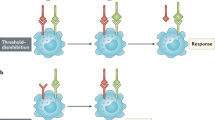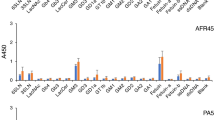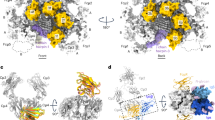Abstract
Previous research suggests that interferon binds to the cell surface1, possibly by attachment to gangliosides2,3. A two-component receptor system consisting of binding and activation sites has been proposed4. This hypothesis is supported by the finding that interferon inhibits binding of cholera toxin and thyrotropin to their receptors5,6 suggesting possible common receptor sites. Moreover, an antiserum against cell surface components of interferon-sensitive cells has been shown to inhibit the action of interferon7. However, to understand the interaction of interferon with the cell surface requires direct ligand-binding studies. I present here direct evidence that high-affinity binding of interferon to a specific cell surface receptor is an initial step in interferon action using biologically active purified 125I-labelled mouse interferon. Labelled interferon binds specifically to interferon-sensitive mouse leukaemia L1210 cells, whereas binding to interferon-resistant L1210 cells is nonspecific. Furthermore, specific binding to monolayer cultures of mouse L929 cells is compared with nonspecific binding to chick embryo fibroblasts insensitive to the action of mouse interferon8.
This is a preview of subscription content, access via your institution
Access options
Subscribe to this journal
Receive 51 print issues and online access
$199.00 per year
only $3.90 per issue
Buy this article
- Purchase on Springer Link
- Instant access to full article PDF
Prices may be subject to local taxes which are calculated during checkout
Similar content being viewed by others
References
Friedman, R. M. Science 156, 1760–1761 (1967).
Besançon, F. & Ankel, H. Nature 252, 478–480 (1974).
Vengris, V. E., Reynolds, F. H. Jr, Hollenberg, M. D. & Pitha, P. M. Virology 72, 486–493 (1976).
Chany, C. Biomedicine 24, 148–157 (1976).
Kohn, L. D., Friedman, R. M., Holmes, J. M. & Lee, G. Proc. natn. Acad. Sci. U.S.A. 73, 3695–3699 (1976).
Grollman, E. F. et al. Cancer Res. 38, 4172–4185 (1978).
Revel, M., Bash, D. & Ruddle, F. H. Nature 260, 139 (1976).
Baron, S., Barban, S. & Buckler, C. E. Science 145, 814–815 (1964).
Tovey, M. G., Begon-Lours, J. & Gresser, I. Proc. Soc. exp. biol. Med. 146, 809–815 (1974).
Sipe, J. D., De Maeyer-Guignard, J., Fauconnier, B. & De Maeyer, E. Proc. natn. Acad. Sci. U.S.A. 70, 1037–1040 (1973).
De Maeyer-Guignard, J., Tovey, M. G., Gresser, I. & De Maeyer, E. Nature 271, 622–625 (1978).
Laemmli, U. K. Nature 227, 680–685 (1970).
Carber, B. et al. J. Biol. Chem. 254, 3681–3684 (1979).
Gresser, I., Fontaine-Brouty-Boyé, D., Bourali, C. & Thomas, M-T. Proc. Soc. exp. Biol. Med. 130, 236–241 (1969).
David, G. S. & Reisfeld, R. A. Biochemistry 13, 1014–1021 (1974).
Stewart II, W. E., De Somer, P. & De Clercq, E. J. gen. Virol. 24, 567–570 (1974).
Gresser, I., Brouty-Boyé, D., Thomas, M-T. & Macieira-Coelho, A. Proc. natn. Acad. Sci. U.S.A. 66, 1052–1058 (1970); J. natn. Cancer Inst. 45, 1145–1153 (1970).
Gresser, I., Bandu, M.-T., Tovey, M. G., Bodo, G., Paucker, K. & Stewart II, W. E. Proc. Soc. exp. Biol. Med. 142, 7–10 (1973).
Gresser, I., Bandu, M-T. & Brouty-Boyé, D. J. natn. Cancer Inst. 52, 553–559 (1974).
Stewart II, W. E. in Effects of Interferon on Cells, Viruses and the Immune System (ed. Geraldes, A.) 75–98 (Academic, New York, 1975).
Gresser, I. & Tovey, M. G. Biochim. biophys. Acta 516, 231–247 (1978).
Stewart II, W. E., De Clercq, E. & De Somer, P. J. Virol. 10, 707–712 (1972).
Kahn, C. R. J. Cell Biol. 70, 261–286 (1976).
Cuatrecasas, P. & Hollenberg, M. D. Adv. Protein Chem. 30, 251–451 (1976).
Author information
Authors and Affiliations
Rights and permissions
About this article
Cite this article
Aguet, M. High-affinity binding of 125I-labelled mouse interferon to a specific cell surface receptor. Nature 284, 459–461 (1980). https://doi.org/10.1038/284459a0
Received:
Accepted:
Issue Date:
DOI: https://doi.org/10.1038/284459a0
This article is cited by
-
Interaction of supraspinally administered interferon-alpha with opioid system in the production of antinociception
Archives of Pharmacal Research (2010)
-
Interferon receptors
Biotherapy (1996)
-
Distribution of mouse interferon-? in normal and brain tumour-bearing mice
Acta Neurochirurgica (1991)
-
Interferon receptors on the surface of interferon-sensitive and interferon-resistant urothelial carcinomas
Urological Research (1990)
-
Interferon receptors
In Vitro Cellular & Developmental Biology (1988)
Comments
By submitting a comment you agree to abide by our Terms and Community Guidelines. If you find something abusive or that does not comply with our terms or guidelines please flag it as inappropriate.



